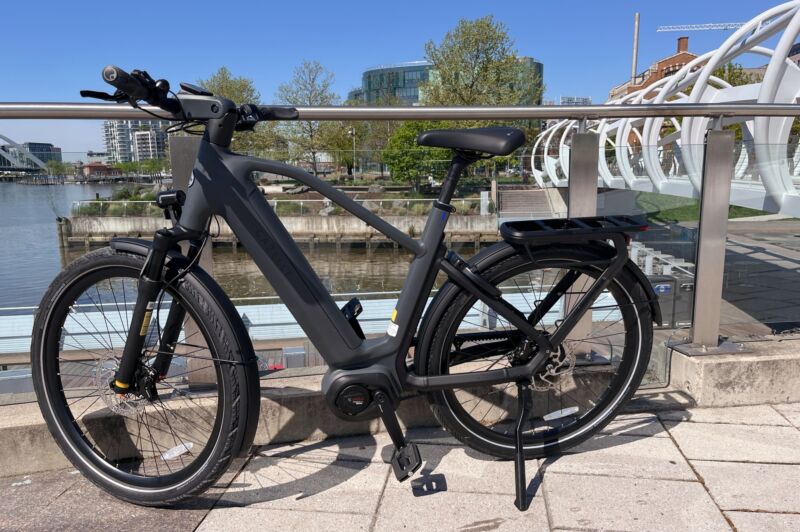
Kevin Purdy
Let me get three negatives about the Gazelle Eclipse out of the way first. First, it’s a 62-pound e-bike, so it’s a pain to ride without the battery. Second, the rack is a chunky, non-standard size, so you might need new bags for it. Third, and this is the big one, at $6,000, it’s expensive, and you’ll probably be nervous about bolting it down somewhere you don’t completely trust it.
But those issues aside, this e-bike is a lot of fun. Riding the Eclipse (the C380+ HMB version of it), I felt like Batman on a day off, or maybe Bruce Wayne out exploring as a bike enthusiast. The matte gray paint, black hardware, and understated but impressively advanced tech certainly helped. But I felt prepared to take on anything that came my way without having to think about it too much. Brutally steep hills, poorly maintained gravel paths, curbs, stoplights, or friends trying to pass me on their lightweight road bikes: the Eclipse was ready for it all.
It supports up to 28 mph (i.e. Class 3) and delivers up to 85 Nm of torque, and the front suspension absorbs bumps without disrupting your confidence in grip. It has integrated lights, the display can show you navigation with your phone tucked away, and the automatic assist switch option balances your mechanical and battery levels so all you have to do is pedal and look.
-
The little switchman, who needs a few rides to get used to him, is either very clever or he is thinking too much about it.
Kevin Purdy
-
The Bosch Kiox 300 is the only e-bike display I've ever spent time customizing and optimizing.
Kevin Purdy
-
The C80+'s drivetrain is a striking thing, well hidden in matte aluminum.
Kevin Purdy
-
The Eclipse's shocks are well-tuned for rough roads, and certainly not for real mountains. (The author knows that the headlight in this photo was at an angle.)
Kevin Purdy
-
The electric pedal assistance on the left handlebar and the small built-in bell that you always replace with something that sounds much louder on new e-bikes.
Kevin Purdy
What kind of bike is this? A nice one.
The Eclipse comes in two main variants, the 11-speed, chain-and-derailleur T11+ HMB model and the stepless Enviolo hub and Gates Carbon belt-based C380+ HMB. Both come in three sizes (45, 50, and 55cm), in one of two colors (Anthracite Gray, Thyme Green for the T11+, and Metallic Orange for the C380+), and with either a low-step or high-step version, the latter with a sloping top bar. Most e-bikes come in two sizes if you’re lucky, typically “Medium” and “Large,” and their suggested bike heights are far too generous. The T11+ starts at $5,500 and the C380+ starts at $6,000.
The Eclipse has an “active” riding position, seemingly halfway between upright Dutch style and a traditional road or flat bar bike. It’s perfect for this kind of riding. The front shocks have a maximum of 75mm of travel, which won’t impress your trail-riding buddies, but makes gravel, dirt, wooden bridges and forest paths a potential option. Everything about the Eclipse tells you to stop worrying about whether you have the right bike for the ride and just get pedaling.
“But I really love cycling and I need a lot of stats and data, during and after the ride,” I hear some of you strawmen say. That’s why the Eclipse has the Bosch Kiox 300, a central display that, for an e-bike, is remarkably readable, navigable, and informative. You can see your max and average speed, distance, what support levels you’re using, power, cadence, and more. You can push navigation directions from Komoot or standard mapping apps on your phone to the display, using Bosch’s Flow app. And of course, you can connect to Strava.
Halfway between maximum efficiency and carefree joyriding, the Eclipse offers a feature that I can only hope will eventually make its way to cheaper e-bikes: automatic assist. Bikes with both gears and motor-assist levels can sometimes leave you guessing which one to change when approaching a hill or pulling away from a standstill. Put the Eclipse in automatic assist and all you have to worry about is the right-hand shifter. There are no gear numbers; there’s a little man on a bike, and as you increase or decrease the gears, the road he’s approaching becomes steep or flat.

